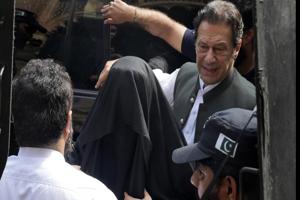
But there will be another factor, one not yet widely considered, that could skew results: the physical forces unleashed by climate change. Analysis by World Weather Attribution, an international scientific consortium, concluded that climate change likely made the extreme precipitation 50 percent more intense. The World Weather Attribution consortium concluded that the month’s maximum heat would have been “virtually impossible” without human-caused climate change. Election officials must therefore understand how climate change can affect elections. During much of that period, human-caused climate change made extreme heat in portions of the country at least fivefold more likely, according to the Climate Shift Index.
This year, at least 68 countries will hold elections, with billions of voters heading to the polls. Voting will be subject to many of the usual electoral risks, including disinformation campaigns, foreign interference, and rigging by incumbents. In some states, both incumbents and challengers could even use violence to keep certain people at home.
But there will be another factor, one not yet widely considered, that could skew results: the physical forces unleashed by climate change. They present a unique and novel challenge. Although all electoral threats are serious, the ones brought by climate change have the potential to disenfranchise voters even in the absence of malevolent intent. The disenfranchisement of even a few voters can make a profound difference in election outcomes, as in the case of the 537 votes in Florida that determined the U.S. presidential election in 2000. As extreme weather events become more frequent, the risk to voters will grow.
Electoral authorities in all countries, including Australia, Canada, India, and the United States, must take action to ensure that—even if polling places, ID cards, and communication networks are damaged or destroyed—citizens can exercise their fundamental democratic right to vote. Options include relocating polling stations, making the rules on registration more flexible, and protecting communications networks.
FLOODING THE POLLS
Since the Industrial Revolution in the mid-1800s, societies have produced ever higher amounts of carbon dioxide and other heat-trapping gases, chiefly by burning fossil fuels. These gases linger in the atmosphere for decades, if not centuries, and there are now more of them in the atmosphere than at any time in the past 4.3 million years. Temperatures are soaring as a result. Every one of the ten hottest years in recorded history occurred during the past decade, with 2023 leading the pack. In the 2015 Paris agreement, 196 countries and international bodies—including China, the United States, and the European Union—pledged to limit the increase in global average temperature to below two degrees Celsius above preindustrial levels, and preferably to 1.5 degrees. But the necessary commitments to achieve these goals have yet to be made, much less implemented. Moreover, although these numbers may sound modest, detailed analyses by the Intergovernmental Panel on Climate Change, the group of scientists charged with informing UN climate negotiations, show that every tenth of a degree of warming above 1.5 has a severe impact. Higher temperatures bring more intensity to hurricanes and cyclones, for example, as well as inland and coastal flooding, wildfires, and extreme heat waves.
In 2023, global temperatures climbed to 1.36 degrees above preindustrial levels. Recent assessments by the UN Environment Program conclude that by 2100 the planet will reach three degrees above preindustrial levels unless current policies are strengthened. Already, extreme-weather disasters are occurring with greater frequency. In the United States, billion-dollar catastrophes—including wildfires, severe storms, and flooding—struck on average every two to three months during the last two decades of the twentieth century. Now they occur on average every two to three weeks. Similar trends likely exist around the world. As a result, emergency responders, government officials, and nongovernmental aid groups have less time to respond, recover, and redeploy. And when weather disasters repeatedly strike a particular community, residents struggling with the aftermath of one calamity find themselves less able to deal with the next—physically, financially, and psychologically.
Such disasters will surely upend elections. Indeed, they already have. Between January 2019 and January 2024, more than a dozen countries contended with extreme weather events around the time of local or national elections, according to the International Institute for Democracy and Electoral Assistance. In March 2019, for example, Mozambique was hit by Cyclone Idai just before the opening of the voter registration period. The storm displaced more than 400,000 people, many of whom lost the identity documents that they needed to register to vote. The storm also destroyed thousands of classrooms used as registration, polling, and vote-counting centers. Six weeks later, Cyclone Kenneth struck, destroying electoral registers, polling materials, and printers. Meanwhile, outbreaks of cholera, which can spike after flooding, further impeded voting.
A similar situation occurred in Pakistan in 2022, when extreme precipitation led to flooding that covered a third of the country before its national contest. Close to eight million people were displaced, with hundreds of thousands moving into temporary shelters. Some of the displaced could not access government-issued national identity cards, which meant that they could neither register nor vote. Meanwhile, floodwaters severely damaged many polling places. It made others completely inaccessible. Analysis by World Weather Attribution, an international scientific consortium, concluded that climate change likely made the extreme precipitation 50 percent more intense.
Richer countries have more resources to respond to climate-worsened disasters. But they are by no means immune to disruption. In the United States, Hurricane Ian hit Florida just six weeks before the 2022 midterm elections, damaging polling locations and other infrastructure used by more than 12 percent of the registered electorate. Rainfall from Hurricane Ian was 18 percent higher than it would have been in the absence of climate change, according to researchers at SUNY and Lawrence Berkeley National Laboratory. Then, beginning in March 2023, Canada suffered the worst year of fires in its history, leaving it struggling to conduct regional elections. Climate change doubled the risk of the spring wildfires by creating hot, dry, and windy conditions, which persisted for the rest of the year. In the fall, wildfires spread to the sparsely populated Northwest Territories and displaced 65 percent of inhabitants in the weeks leading up to the general election. And in Spain, extreme heat during July 2023 prompted some voters to don swimwear to cast their ballots. The World Weather Attribution consortium concluded that the month’s maximum heat would have been “virtually impossible” without human-caused climate change.
EXPECT THE UNEXPECTED
If current trends continue, extreme weather events will increasingly compromise citizens’ right to vote. Election officials must therefore understand how climate change can affect elections. They must think, of course, about election day itself, when voters must often stand outdoors for hours in line to cast their votes. In an era of extreme heat, such queues will be dangerous for those at risk of heat stress, including those over 65 or with medical conditions, as well as pregnant women and children brought by their parents. But election day is just the tip of the iceberg. As previous disasters have made evident, extreme-weather events can disrupt activities along the months-long electoral process, from voter registration through to vote counting. Severe weather can also impact candidates’ campaigns, as well as canvassing by their supporters.
Climate disruptions hardly end when extreme weather does. Voters driven from their homes by emergency conditions may flee without the identity documents they need to register or cast a ballot. Even if they do get their papers out, floodwaters or flames may damage or destroy them. Voters may also face lengthy periods of displacement far from their assigned polling places if their homes remain uninhabitable. Even for those voters who are not displaced, road closures and other lingering transportation disruptions can make it impossible to reach the polls. Similarly, climate-worsened disasters can displace election officials and poll workers, rendering them unable to reach their offices or polling stations, which may themselves have been damaged or destroyed. When storms interrupt power supplies, election officials face additional challenges both in keeping polling places operational and in communicating with colleagues and the public. And ballots themselves can be destroyed by the same elements that take out identity documents, either before distribution or after their collection.
If current trends continue, extreme weather events will increasingly compromise citizens’ right to vote.
Regardless of whether one’s vote determines the outcome of an election, individuals who are unable to vote because of climate-driven extreme weather lose a fundamental democratic right. Preparing for the inevitable worsening of climate impacts on elections is, therefore, essential. Yet almost no one has taken action. The U.S. Election Assistance Commission, for example, advised in 2014 that “advance planning minimizes the disruption and aids in a quick recovery while preserving the security and integrity of the election.” But a decade later, U.S. election officials have largely ignored climate risks in their planning, even as they make other changes to the electoral system. Americans can increasingly vote by mail, for example, but battered roads may prevent postal services from delivering ballots or conveying completed ballots to election officials.
Other countries are also failing. In 2023, the Election Commission of India revised its Manual on Electoral Risk Management to include a section on natural disasters. The updated manual, however, makes no mention of climate change or extreme heat. This is despite the fact that most voters under 80 are required to vote in person and India has experienced high temperatures during this year’s elections, which began in April and stretch into early June. During much of that period, human-caused climate change made extreme heat in portions of the country at least fivefold more likely, according to the Climate Shift Index. To protect human health, the head of the Indian meteorological service, Mrutyunjay Mohapatra, urged authorities to provide adequate supplies of water, as well as fans and air-conditioned spaces. Notwithstanding these measures, voter turnout was significantly lower than normal, prompting Indian authorities to create a task force to examine the impact of heat waves on the election. News reports indicate that at least 77 people died from the extreme heat during the final ten days of voting, including 33 poll workers.
Elsewhere election officials have embraced new, more flexible approaches, on a mostly ad hoc basis. Following a devastating storm in Quebec in 2022, Canada extended polling station hours. In the midst of the 2023 wildfires, the province of Alberta offered to mail special ballots to 29,000 evacuated residents and the Northwest Territories broadened its “Vote Anywhere” initiative, allowing voters to use any polling location within the jurisdiction. The Territories also postponed its elections by six weeks. After flooding in 2022, Australia allowed flood victims to vote by phone, an option that previously had been allowed only for disabled voters because of the significant staff time required. Meanwhile, in the United States, California has developed mobile voting units that it can deploy during disasters. But these initiatives, although all useful, are not yet broad enough, or systemic enough, to make sure elections are resilient to disasters.
VOTING IN A WARMING WORLD
To better account for climate change, election officials can start by improving their own capacity to prepare for and respond to disasters through training and planning. Officials can, for example, use widely available tools to assess climate risks when organizing elections, including Climate Central’s Coastal Risk Screening Tool, which provides free, highly localized flood risk maps for coastal communities—allowing officials to identify safer locations for polling stations. Artificial intelligence may be able to play a role in site selection by digesting data on vulnerabilities, population locations, power sources, potential transportation disruptions, and other variables.
Officials must also afford themselves greater flexibility in running elections. Experts at the International Institute for Democracy and Electoral Assistance and the International Foundation for Electoral Systems recommend measures such as allowing same-day voter registration, thereby permitting citizens to register and cast ballots in a single process, and creating online systems to enable voters to update their addresses more easily after displacement. Another option is allowing voters multiday periods in which to cast their votes. Officials could also let voters obtain replacement or temporary ID cards at no cost. Similarly, installing backup election and power equipment, creating alternative methods to produce or reprint ballots, and expanding avenues of public outreach can lessen voting disruptions.
Major disasters typically disrupt communications, meaning that climate-resilient election plans should include robust methods to inform citizens of when and where to vote, and to inform polling officials of changes to their duties. Where electrical power is available, radio and television announcements can spread information about alternative polling places, expanded times, and other adjustments, as can social media if connectivity allows. Nongovernmental organizations can help election officials in getting the word out. In the United States, the Lawyers’ Committee on Human Rights runs nonpartisan hotlines to answer questions from voters regarding election processes. Such hotlines can help disseminate updated information.
The right to vote is fundamental to democracy. Climate extremes will batter and test it, as they already have. But building more resilient election infrastructure and introducing greater flexibility in how, when, and where people register and vote can limit the damage. Doing so will be increasingly essential on a rapidly warming planet. Every voter should have the ability to cast a vote that gets counted—no matter the weather.
©All Rights Reserved.






